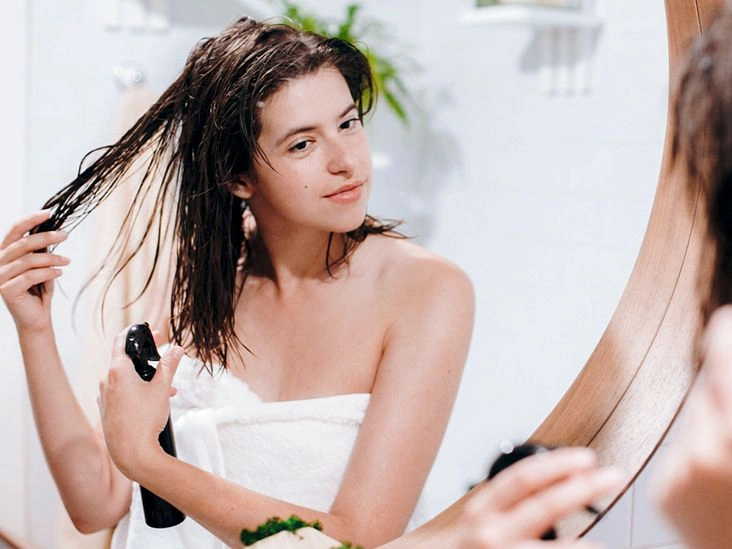Your body naturally keeps your hair hydrated through sebaceous (oil) glands on the scalp, which produce sebum. That sebum then travels from the scalp to coat and lubricate the rest of your hair strands.
Occasionally this natural hydration process may fall short. You might have underactive oil glands because of genetics or aging. Your hair’s texture and length can also prevent sebum from reaching the lengths of your hair efficiently. Excessive washing, heat styling, and chemical treatments can further contribute to dry hair.
Once you identify your hair type and current moisture level, you can address dry hair at home. Consider the following strategies to get started.

How to moisturize curly hair
Curly hair is the most prone to dryness. Because of the curl pattern, sebum requires more time to travel down the shaft to hydrate the curls. Washing and styling curly hair too often can exacerbate dryness.
Treat parched, curly locks with deeply hydrating shampoos and conditioners. Look for nourishing oils and butters in the ingredient list, such as:
- avocado
- almond
- argan
- olive
- monoi
- coconut
These ingredients are known to help lock in moisture. You can also apply these oils individually as a weekly hair mask.
How to moisturize thick and coarse hair
If your thick hair has become coarse and dry, consider an intensive moisturizing treatment. Shea butter is particularly effective for very dry strands because of its rich fatty acids and antioxidant content.
Using a hair mask once a week can help restore hydration. Always apply a heat-protectant spray before using hot styling tools.
How to moisturize fine hair
Fine hair is generally less prone to moisture loss because sebum can move more readily along finer strands.
However, if you color your hair, use heated tools frequently, or wash too often, you may experience dryness. Choose a lightweight shampoo and conditioner formulated for fine hair.
Focus moisturizing products on the ends of your hair only — applying conditioner to an already oily scalp can weigh hair down. Natural options that are usually safe for fine hair include jojoba and lavender oils.
How to moisturize mature hair
Mature and gray hair often becomes drier as sebaceous gland activity declines with age.
You can counteract this by using a deeply hydrating shampoo and conditioner, plus a leave-in moisturizing spray. Cutting back on how frequently you wash your hair each week can also help reduce excessive dryness.
How to apply moisturizers to your hair
When using a moisturizing conditioner or mask, start applying the product to the ends of your hair first, then work upward toward the mid-lengths. It’s usually unnecessary to apply moisturizer to the scalp unless it is very dry.
Apply moisturizer to wet hair only — wet strands absorb product more effectively. While some leave-in or daily conditioners are safe for more frequent use, reserve deep treatments for about once a week.
For optimal results, leave a hair mask or oil treatment on for up to 20 minutes before rinsing. Use cool or lukewarm water to rinse; hot water can increase damage and dryness.
Should you put skin moisturizer in your hair?
Although there are multipurpose products marketed for both skin and hair, a skin moisturizer usually isn’t the best option for dry hair.
Skin lotions may be either too light or overly greasy for hair, depending on the formula. While they won’t reliably hydrate hair, they can temporarily tame frizz when you’re in a pinch.
If you don’t have hair-specific moisturizers available, a small amount of skin lotion on the ends can work temporarily until you obtain appropriate hair products.
What causes dry hair?
At its core, dry hair results from insufficient sebum. You may be predisposed if your scalp naturally produces less oil due to genetics, or if sebaceous gland output diminishes with age or environmental factors.
Curlier and longer hair types are more prone to dryness because sebum takes longer to travel from the scalp to the ends.
Daily habits can also play a large role. Frequent use of heated tools like blow dryers, curling wands, and flat irons can damage the hair cuticle, making strands more vulnerable to breakage and moisture loss.
Excessive chemical treatments, such as coloring and straightening, can similarly weaken the cuticle.
Overwashing is another common cause of dry hair. As a general guideline, you only need to shampoo daily if your hair is visibly dirty or oily; using dry shampoo between washes can help maintain moisture.
Takeaway
One treatment may offer some relief from dry hair, but noticeable improvement often requires repeated care and changes in routine. Adjusting lifestyle and hair care habits will enhance outcomes.
If home remedies don’t improve your hair’s dryness, consult your stylist for professional product suggestions. You may also want to seek a dermatologist’s advice if the problem persists.


















Leave a Reply
You must be logged in to post a comment.